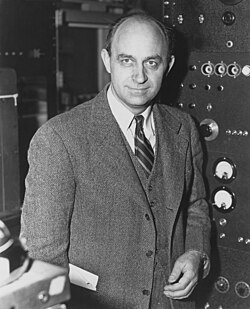Enrico Fermi
The "Scots" that wis uised in this airticle wis written bi a body that haesna a guid grip on the leid. Please mak this airticle mair better gin ye can. (October 2020) |
Enrico Fermi (29 September 1901 – 28 November 1954) wis an Italian-American physicist an the creautor o the warld's first nuclear reactor, the Chicago Pile-1. He haes been cried the "airchitect o the nuclear age"[1] an the "airchitect o the atomic bomb".[2] He wis ane o the verra few physicists in history tae excel baith theoretically an experimentally. Fermi held several patents relatit tae the uise o nuclear pouer, an wis awairdit the 1938 Nobel Prize in Physics for his wirk on induced radioactivity bi neutron bombardment an the diskivery o transuranic elements. He made signeeficant contreibutions tae the development o quantum theory, nuclear an pairticle physics, an stateestical mechanics.


Fermi's first major contreibution wis tae statistical mechanics. Efter Wolfgang Pauli annoonced his exclusion principle in 1925, Fermi follaed wi a paper in that he applee'd the principle tae an ideal gas, employin a stateestical formulation nou kent as Fermi–Dirac stateestics. The day, pairticles that obey the exclusion principle are cried "fermions". Later Pauli postulatit the exeestence o an unchairged inveesible pairticle emittit alang wi an electron in beta decay, tae satisfee the law o conservation o energy. Fermi teuk up this idea, developin a model that incorporatit the postulatit pairticle, that he named the "neutrino". His theory, later referred tae as Fermi's interaction an still later as waik interaction, descrived ane o the four fundamental forces o nature. Throu experiments inducin radioactivity wi recently diskivered neutrons, Fermi diskivered that slow neutrons war mair easily capturt nor fest anes, an developed the Fermi age equation tae descrive this. Efter bombardin thorium an uranium wi slaw neutrons, he concludit that he haed creatit new elements; awtho he wis awairdit the Nobel Prize for this diskivery, the new elements war subsequently revealed tae be fission products.
Fermi left Italy in 1938 tae escape new Italian Racial Laws that affectit his Jewish wife Laura Capon. He emigratit tae the Unitit States whaur he wirked on the Manhattan Project in Warld War II. Fermi led the team that designed an biggit Chicago Pile-1, that went creetical on 2 December 1942, demonstratin the first artifeecial sel-susteenin nuclear cheen reaction. He wis on haund whan the X-10 Graphite Reactor at Oak Ridge, Tennessee, went creetical in 1943, an whan the B Reactor at the Hanford Site did sae the next year. At Los Alamos he heidit F Division, pairt o that wirked on Edward Teller's thermonuclear "Super" bomb. He wis present at the Trinity test on 16 Julie 1945, whaur he used his Fermi method tae estimate the bomb's yield.
Efter the war, Fermi served unner J. Robert Oppenheimer on the General Advisory Committee, that advised the Atomic Energy Commission on nuclear maiters an policy. Follaein the detonation o the first Soviet fission bomb in August 1949, he strangly opposed the development o a hydrogen bomb on baith moral an technical grunds. He wis amang the scientists that testifee'd on Oppenheimer's behauf at the 1954 hearin that resultit in the denial o the latter's siccarity clearance. Fermi did important wirk in pairticle physics, especially relatit tae pions an muons, an he speculatit that cosmic rays arose throu material bein acceleratit bi magnetic fields in interstellar space. Mony awairds, concepts, an institutions are named efter Fermi, includin the Enrico Fermi Awaird, the Enrico Fermi Institute, the Fermi Naitional Accelerator Laboratory, the Fermi Gamma-ray Space Telescope, the Enrico Fermi Nuclear Generatin Station, an the synthetic element fermium, makkin him ane o 16 scientists that hae elements named efter them.
References
eedit- ↑ "Enrico Fermi, architect of the nuclear age, dies". Autumn 1954.
- ↑ "Enrico Fermi Dead at 53; Architect of Atomic Bomb". New York Times. 29 November 1954. Retrieved 21 Januar 2013.
Soorces
eedit- Laura Fermi, Atoms in the Family: My Life with Enrico Fermi (Chicago: Varsity o Chicago Press, 1954) ISBN 0-226-24367-2
- Richard Rhodes, The Making of the Atomic Bomb (New York: Simon an Schuster, 1986).
- C. P. Snow, "The Physicists" (Toronto: Little, Brown, 1981)
- Fermi's audio biography at the Varsity o Chicago wabsteid. (http://www-news.uchicago.edu/fermi/resources.html)
Fremmit airtins
eedit| Wikimedia Commons haes media relatit tae Enrico Fermi. |
- A photographic archive o Fermi an the Panisperna louns Archived 2005-04-04 at the Wayback Machine
- Aboot Enrico Fermi
- Life an warks o Enrico Fermi Archived 2006-02-12 at the Wayback Machine (in Italian)
| Wikimedia Commons haes media relatit tae Enrico Fermi. |